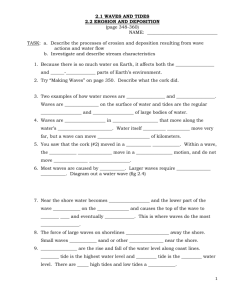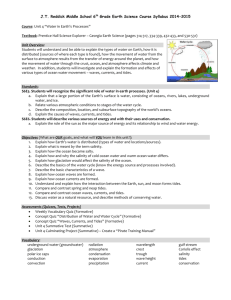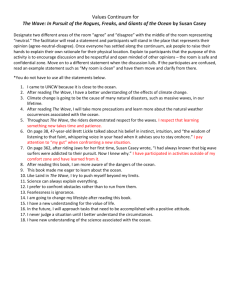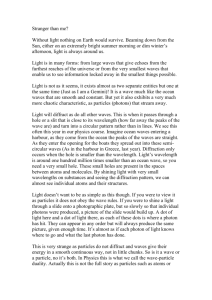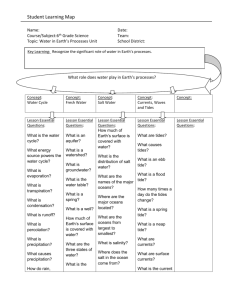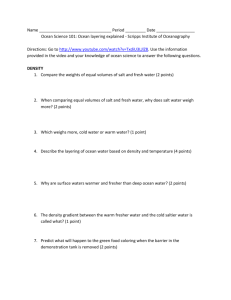chap13 - Cal State LA - Instructional Web Server
advertisement
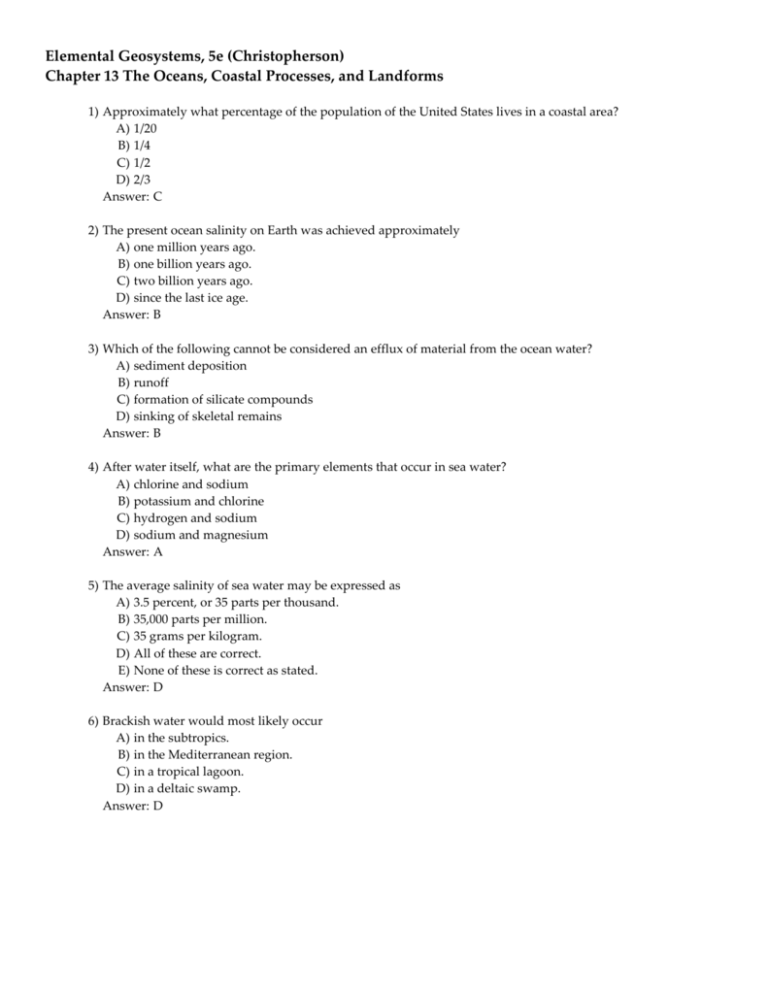
Elemental Geosystems, 5e (Christopherson) Chapter 13 The Oceans, Coastal Processes, and Landforms 1) Approximately what percentage of the population of the United States lives in a coastal area? A) 1/20 B) 1/4 C) 1/2 D) 2/3 Answer: C 2) The present ocean salinity on Earth was achieved approximately A) one million years ago. B) one billion years ago. C) two billion years ago. D) since the last ice age. Answer: B 3) Which of the following cannot be considered an efflux of material from the ocean water? A) sediment deposition B) runoff C) formation of silicate compounds D) sinking of skeletal remains Answer: B 4) After water itself, what are the primary elements that occur in sea water? A) chlorine and sodium B) potassium and chlorine C) hydrogen and sodium D) sodium and magnesium Answer: A 5) The average salinity of sea water may be expressed as A) 3.5 percent, or 35 parts per thousand. B) 35,000 parts per million. C) 35 grams per kilogram. D) All of these are correct. E) None of these is correct as stated. Answer: D 6) Brackish water would most likely occur A) in the subtropics. B) in the Mediterranean region. C) in a tropical lagoon. D) in a deltaic swamp. Answer: D 7) The fact that the mixing zone in the ocean constitutes a ________ percentage of the total ocean volume means that wastes dumped into the ocean will be ________ diluted. A) large; quickly B) large; slowly C) small; quickly D) small; slowly Answer: D 8) Which of the following is true of the ocean deep zone? A) Temperatures remain approximately 4 degrees C (39 degrees F) within most of this layer. B) The water in this zone does not freeze because of the intense pressure exerted by the weight of overlying water. C) The water in this zone does not freeze because of its salinity. D) All of these are true. Answer: D 9) The littoral zone extends inland to A) the foreshore dune. B) the backshore dune. C) the trough between the primary and secondary dune. D) the highest water line that occurs during a storm. Answer: D 10) The coast extends inland A) to the foreshore dune. B) to the backshore dune. C) to the trough between the primary and secondary dune. D) to the highest water line that occurs during a storm. E) from the high tide level to the first major landform change. Answer: E 11) The coastal environment is considered to extend seaward A) usually to depths of 60 m (200 ft), where storm waves can no longer move sediments. B) only to the contact point between the sea and the land, i.e., the shoreline. C) out to as far as you can see the bottom. D) into the breakers. Answer: A 12) Which of the following is true regarding mean sea level? A) A consistent value has yet to be determined due to all the variables involved in producing the tides. B) It is at the same level along the entire North American coast. C) It is calculated based on average tidal levels recorded hourly at a given site over a period of many years. D) The sea level along the Gulf Coast is the lowest for the coasts of the lower 48 states. Answer: C 13) Which of the following is incorrectly matched? A) rising tides flood tides B) ebb tides falling tides C) spring tides high tides only D) spring tides maximum tidal range Answer: C 14) Which of the following is not true of tides? A) They are produced solely by the gravitational pull of the Sun. B) They are complex daily oscillations in sea level. C) They are influenced by the size, depth, and topography of ocean basins. D) They are influenced by shoreline configuration and latitude. Answer: A 15) Which of the following occurs when the Sun, Moon, and Earth are in alignment (i.e., in opposition or conjunction)? A) maximum tidal ranges occur B) neap tides occur C) a lower tidal range occurs D) None of these this type of alignment does not happen in nature. Answer: A 16) Regular patterns of smooth, rounded waves are called A) breakers. B) wave ripples. C) wave trains. D) swells. Answer: D 17) Dangerous "sleeper waves" result from A) earthquakes. B) volcanic eruptions. C) submarine landslides. D) constructive, in-phase interference. Answer: D 18) Which of the following is true of waves that travel in wave trains? A) They are produced by storm centers and generating regions far distant from the shore where they may break. B) They usually form relatively close to the affected coastline. C) They experience refraction by the deep seafloor. D) They are called breakers as they travel in the open sea. Answer: A 19) In deep water, a wave is not really migrating but is transferring energy through the water in simple cyclic undulations. These are called A) waves of translation. B) swells. C) waves of transition. D) tidal waves. Answer: C 20) Waves in shallow water that "feel bottom" are ________ and more ________ spaced than the swell they are related to. A) taller; closely B) taller; widely C) smaller; closely D) smaller; widely Answer: A 21) As a wave approaches the shoreline and enters shallower water, energy and water move forward causing the water to rise and cascade down from the wave crest as a breaker. These waves are called A) waves of translation. B) swells. C) waves of transition. D) tidal waves. Answer: A 22) Wave action works to straighten a coast as wave energy focuses around headlands and tends to disperse energy in coves and bays in a process called A) longshore current. B) breakers. C) wave refraction. D) tidal bore. Answer: C 23) A sea stack (i.e., an isolated pillar of rock located offshore) is the erosional remnant of a A) volcanic neck. B) spit. C) tombolo. D) rocky headland. Answer: D 24) A longshore current involves all of the following except A) effective wind direction. B) effective wave direction. C) waves of transition. D) transportation of large amounts of sand and coastal materials. Answer: C 25) Particles of sand, gravels, and shells that move along the shore form the A) breakers. B) longshore current. C) beach drift. D) translation effects. Answer: C 26) When people go surfing or swimming along a coast, they often find after spending time in the water that they are no longer in the area in which they first entered the water. In other words, they find that they have moved downshore, even though they did not deliberately move in that direction. This occurs because of A) tsunamis. B) beach drift. C) longshore currents. D) tidal currents. Answer: C 27) An earthquake, submarine landslide, or eruption of an undersea volcano is capable of producing a A) tsunami. B) tidal wave. C) slow-moving giant swell. D) wave in the open ocean of great height. Answer: A 28) Which of the following is not true of tsunamis? A) They can travel at a speed of several hundred miles per hour. B) They have very long wavelengths in the open ocean. C) They are very tall in the open ocean. D) They slow down as they approach shore. Answer: C 29) Several years ago, a movie was made about a cruise ship that was overturned by a tsunami while at sea. This plot is not valid because A) tsunamis do not have the energy to overturn a ship of that size. B) tsunamis do not occur in the open ocean. C) tsunamis do not form high waves while in the open ocean. D) All of these are true. Answer: C 30) The height of a tsunami grows as it approaches a coastline primarily because A) its energy level increases. B) its wavelength shortens. C) the height of the surf is added to the height of the tsunami. D) None of the above are true the height of a tsunami remains constant from the time of its origin. Answer: B 31) Which of the following is not true of the December 2004 tsunami? A) The earthquake that triggered it involved 13.7 m (45 ft) of uplift. B) Earth's rotation was slowed by 3 milliseconds. C) Wave heights in the open ocean were 11.3 m (24 ft). D) Energy from the waves travelled around the world several times. Answer: C 32) Which of the following is true of worldwide sea level? A) Over the long term, levels have been very constant. B) Changes in sea level are usually unrelated to tectonic processes. C) Changes seem to occur without any relation to global average temperatures. D) It was about 130 m (430 ft) lower 18,000 B.P., and about 10 cm lower 100 years or so ago. Answer: D 33) Given present global warming trends and predicted climate change for the next century, sea level is estimated to rise A) between 11 cm and 88 cm (4.3 in to 34.6 in). B) in an amount unrelated to the temperature of the ocean. C) more than 30 m (100 ft). D) in a way that will not threaten coastal inhabitants. Answer: A 34) Which of the following would not be found along a tectonically active shoreline? A) sea stacks B) terraces C) barrier islands D) cliffs Answer: C 35) Which of the following is not an example of an erosional coastal landform? A) sea arch B) tombolo C) wave-cut platform D) notched cliff Answer: B 36) A terrace is A) an uplifted sea stack. B) an uplifted wave-cut platform. C) an erosional surface created by a massive tsunami. D) an uplifted foreshore dune. Answer: B 37) Which of the following is not an example of a depositional coastal landform? A) wave-built terrace B) barrier spit C) bay barrier D) wave-cut platform Answer: D 38) Sand that extends from a coast into open water is called a A) barrier island. B) lagoon. C) barrier spit. D) tombolo. Answer: C 39) Generally speaking, "beaches" span the zone A) between high and low spring tides. B) from several feet above high tide to several feet below low tide. C) between high and low neap tides. D) from the high tide line during a spring tide to the low tide line during a neap tide. Answer: B 40) In order to preserve their beaches, cities located along a coast will often build groins that protrude into the sea. What is the result of this process? A) Sediment is deposited on the side of the groin facing into the current, and this results in deposition in the desired location. B) More sediment is made available to areas downshore, so they also benefit from this engineering process. C) Less sediment is available to areas downshore, so their beaches begin to erode. D) both A and B E) both A and C Answer: E 41) Human intervention along a coastline intended to interrupt beach drift can include all of the following except A) tombolo placement. B) jetty. C) breakwater. D) protected harbor entrance. Answer: A 42) Which of the following conditions is not conducive to the formation of barrier islands? A) tectonically active coasts B) sediment supply from rivers C) low tidal range D) presence of continental shelf Answer: A 43) The most extensive chain of barrier islands in the world is along A) the western coast of Australia. B) the coasts that surround the periphery of the Indian Ocean. C) the Atlantic and Gulf coasts of North America. D) the coast of California, Oregon, Washington, and British Columbia. Answer: C 44) Barrier islands make ________ sites for real estate development because ________. A) good; they provide excellent scenery B) good; they are made of rock and are quite stable C) poor; they are unstable and often mobile D) poor; they can be overrun by storm surges E) both C and D Answer: E 45) Barrier beaches and islands occur worldwide, lying offshore of nearly ________ of Earth's coastlines. A) 10 percent B) 50 percent C) 70 percent D) 90 percent Answer: A 46) The Pacific Rim can be characterized as A) a place of embayments. B) being dominated by estuaries. C) being dominated by barrier islands. D) tectonically active and emerging. Answer: D 47) Coral formations A) tend to occur poleward of 30° latitude. B) survive in a broad ecological range because they are tolerant of temperature, salinity, and depth variation. C) require water that is high in sediment concentration. D) are made of animals living symbiotically with simple algae. Answer: D 48) Because the algae that live in symbiotic relationship with coral perform ________, corals ________. A) chemosynthesis; must live in water that is penetrated by light B) chemosynthesis; can live at virtually any depth in the sea C) photosynthesis; must live in water that is penetrated by light D) photosynthesis; can live at virtually any depth in the sea Answer: C 49) An atoll is approximately ________ in shape because it forms ________. A) circular; around seastacks B) circular; around submerged volcanic islands C) linear; along barrier islands D) linear; along continental shorelines Answer: B 50) Coral bleaching refers to A) the killing of coral formations by chlorine bleach pollution. B) the replacement of normal, colored algae by white algae. C) the loss of algae from the coral. D) All of the above are included within the definition of coral bleaching. Answer: C 51) Coral bleaching may result from A) pollution. B) disease. C) global warming. D) sedimentation. E) all of these Answer: E 52) Which of the following is false regarding coral bleaching? A) By the end of 2000 30 percent of reefs were lost. B) It is only occurring in the southern hemisphere. C) It may be caused by global warming. D) It may be caused by local pollution and sedimentation. Answer: B 53) As regards wetlands, which of the following is correctly matched? A) salt marsh between the equator and the 30th parallel in both hemispheres B) salt marsh poleward of the 30th parallel in either hemisphere C) mangrove swamps poleward of the 30th parallel in either hemisphere D) salt marshes low productivity due to the salinity Answer: B 54) The geographic boundary between salt marshes and mangrove swamps is determined by A) tectonic activity. B) salinity. C) the occurrence of freezing conditions. D) precipitation levels. Answer: C 55) Cape Hatteras is an example of A) a barrier island. B) the Inner Banks. C) a type of breakwater. D) a stable landform that is a good site for development. Answer: B 56) The sinuous, branching channels that characterize a salt marsh result from A) spawning beds made by fish. B) storm tracks. C) manmade drainage canals. D) the ebb and flow of tides. Answer: D 57) Which of the following areas along a coast is most tolerant of construction? A) beach B) primary dune C) secondary dune D) back dune Answer: D 58) Approximately two thirds (66 percent) of the world's population lives in or near a coastal region. Answer: True False 59) Water can be considered a "universal" solvent. Answer: True False 60) The salinity of seawater averages 3.5 percent, or 35 parts per thousand. Answer: True False 61) Although many elements are dissolved in seawater, no gases are dissolved in it. Answer: True False 62) The coastal environment is also known as the littoral zone. Answer: True False 63) Determining mean sea level requires measurement of tidal levels hourly for at least a period of several years. Answer: True False 64) A wave in the open ocean consists of water molecules traveling in the direction of wave propagation. Answer: True False 65) Plunging breakers develop where the bottom profile of the coast is steep. Answer: True False 66) Headlands are the location of diverging wave action, whereas bays receive converging wave action. Answer: True False 67) Tsunamis generated by earthquakes can form giant waves while traveling in the open ocean. Answer: True False 68) A tombolo cuts off a portion of the ocean along a coast, forming a lagoon. Answer: True False 69) A mere one foot rise in sea level along the shores of North America could cost hundreds of billions of dollars in damages. Answer: True False 70) A beach acts to stabilize a shoreline by absorbing wave energy, even though materials are in almost constant motion. Answer: True False 71) A single groin can produce both sand erosion and deposition. Answer: True False 72) Barrier islands are stable islands that are suitable for development. Answer: True False 73) Worldwide, corals are healthy and appear not to be affected by pollution, changes in surface ultraviolet radiation, or increases in ocean temperatures at this time. Answer: True False 74) Coral bleaching results in the death of corals. Answer: True False 75) The barrier islands off the Louisiana shore have been growing at fast rates in recent decades. Answer: True False 76) Seawater is a solution, and the concentration of dissolved solids in it is referred to as its ________. The term ________ is applied to water that exceeds the average of 35 percent, whereas ________ is the term used to describe water that is less than 35 percent. Answer: salinity; brine; brackish
